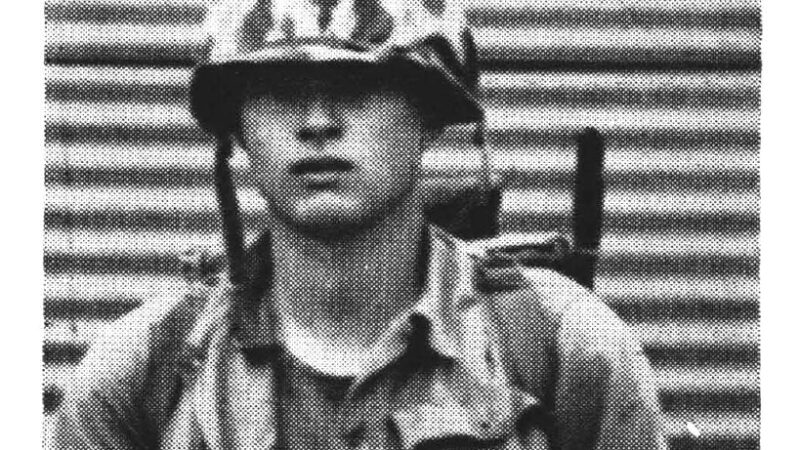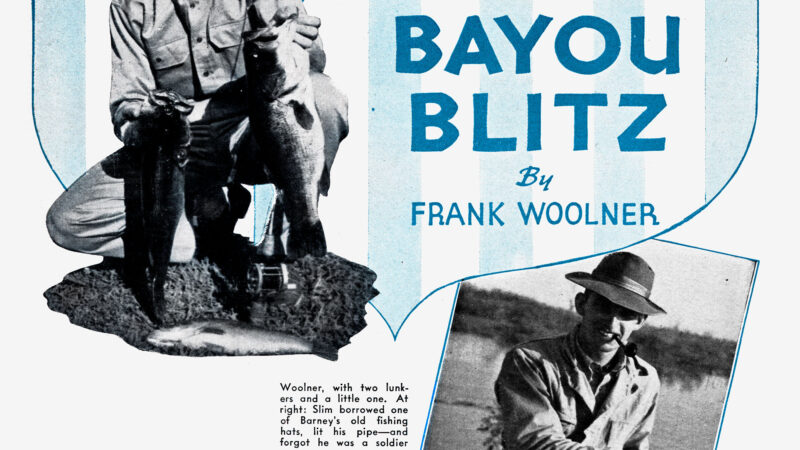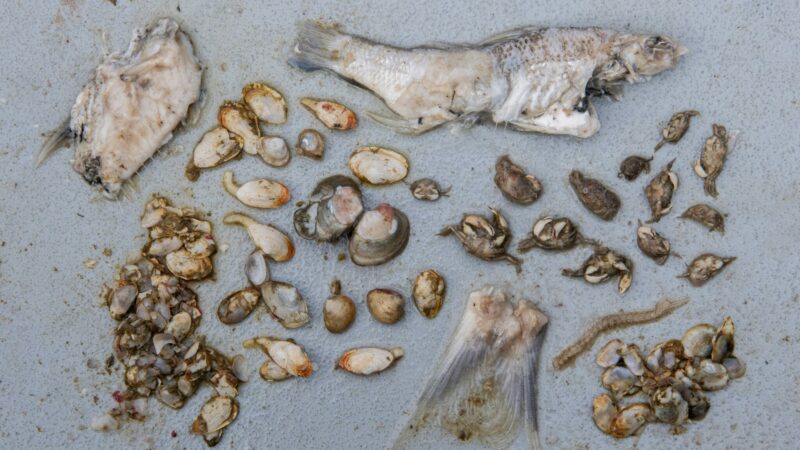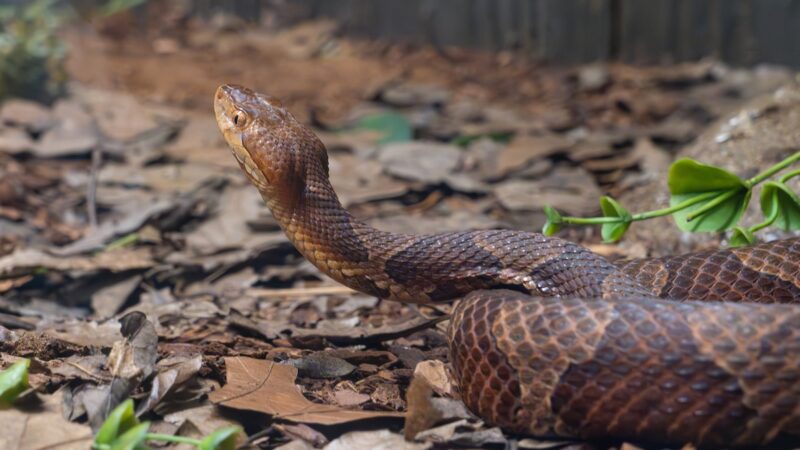I Moved to Ireland, Where Snipe are the Ultimate Game Bird
This story, “Back to the Bogs,” appeared in the June 1972 issue of Outdoor Life.
“Do you know the bogs at all, Mr. Riley?” asked a member of the Garryricken Club in Kilkenny as he sent me out on my first shoot in Ireland.
“I’ve heard the bogs can be treacherous,” I ventured.
“It’s not their treachery I was thinking of. I was thinking you’d best have a look in them for the snipe.”
“Snipe?” I was frankly puzzled.
A few weeks later the subject came up again at the Carlow Gun Club outside Tullow as my guide (ghillie) watched me fill my cartridge belt.
“Have you none of the eights then?” the ghillie asked.
“Only sixes,” I said.
“A bit thin in the pattern for snipe,” the ghillie answered.
Queer talk, it seemed to me, because I was going out to shoot pheasants — the most gorgeous, flamboyant, delicious pounders in the world — not a needlenosed three-ounce creature that looks like a bran muffin on toothpicks.
Out in the green fields I discovered the ghillies hand-signaling the pointers into bogs. Once the men knelt beside a muddy patch as delighted as if they’d come upon a keg of stout.
“The wee holes there in the muck, do you make them out?”
I could.
“A snipe ate here only the evening past. Have you never seen the snipe eat?”
I had not.
“He favors the earthworm. He stands there with his head cocked, listening — do you follow me? And when he hears the worm crawling there beneath his thin feet the bird drives his bill down clear to the eye — the eye being set to the back of the head so he doesn’t get the muck in it.”
I hadn’t seen a single yet — they hadn’t come in from England and the Continent. I couldn’t have cared less; the pheasant shooting was such a pleasure. In sunny weather, with genial companions and thousands of acres of comely Irish-countryside to rove; with fine pointers and ghillies eager to “present” each bird properly, I managed to bring down a dozen cocks. There had been lunches in country pubs and teas in farmhouses where the hot apple pie had cream on it that you could trot a mouse across. All for $10 a day.
Yet when we gathered in a pub after the shoots and sat before a turf fire, the Irish didn’t talk about pheasants, or the mallards down in the bogs and rivers, or the white-fronted geese in the nearby Wexford Slobs (right — slobs), or the numberless wood pigeon, or the grouse, or the partridge; they talked snipe.
This habit struck me as peculiar, for the Irish are avid, sophisticated sportsmen. Irish coins, for instance, don’t bear images of politicians or poets or martyrs; they have a salmon on one, a hare on another, a bird (grouse I think) on a third, and a greyhound, a racehorse, and a woodcock on others. When you enter a cab with a cased shotgun, you’re immediately involved in a discussion of chokes and side-locks, ballistics, and the terrible price of English double-barrels. Last week I rode with a cabby who shot a Purdey that was undoubtedly worth more than his cab.
How a people such as this, steeped in shooting, surrounded by a variety and abundance of game, could be so hung-up on snipe I couldn’t grasp. And not just the Irish — Europeans, particularly the French, are crazy about the little bird that flies crooked; they come to Ireland in sizable numbers to shoot him.
To me, a North Dakota boy, snipe-hunting still bears the smell of a hoax. Snipe-hunting was what we did to city slickers in revenge for our having bought the Brooklyn Bridge from them; it was in the same league with a bucket of steam.
My personal relations with snipe have been fleeting and irritating. These birds were the demons that leaped from under my feet as I trudged home from a duck pond. The snipe not only gave me many a nasty start; he was also the only bird I ever saw who was capable of flying off in all directions at the same time. If my duck shoot had been a bust and I was feeling peevish, I usually gave the snipe a blast, more in spleen than in hope. Once every decade or so I hit one; the last was in 1968. I remember because I ate him.
With pheasants hanging in the stone house next door and the woodcock not yet in, with the season getting on, and with all the chatter about snipe, I decided I might as well give them a whirl. I called Noel Kavanagh.
Since my wife Betty and our three daughters — Liz, Katie, Jan — left Manhattan Beach, California, a few months ago to see how we’d like living without smog, the best way to go shooting in Ireland is to call Noel Kavanagh. He’s the Game and Wildlife Officer for the Bord Fáilte (pronounced Fall-ta), which is Irish for Tourist Board. Noel is an amiable and intelligent young man who knows where every bird in Ireland is and what it is doing. He is one of the Irishmen who are working to build up Irish shooting for foreigners.
Nowadays the Bord Fáilte and the Land Commission are buying up game rights from individual farmers for gun clubs to use, with the stipulation that the clubs provide shooting for tourists. Some clubs have astounding spreads. One in County Clare has 100 square miles.
The clubs are bargains for American hunters. For a gun permit fee of $7.80, you can shoot grouse in Donegal in September; ducks, geese, snipe, and other waterfowl all over the island from September to February; pheasant from the first of November; and woodcock from whenever they arrive until January 31. The daily charge is from $7.50 to $12 a day for ghillie, dog, and game.
I asked Noel where to go for the famous snipe of Ireland.
“Galway,” he said. “Get in touch with Christy Meehan in Tuam.”
Over the phone, Christy Meehan said that snipe shooting was excellent, but to come over on Thursday rather than Friday. A party of Frenchmen would arrive on Friday, and Frenchmen require constant care. So I rented a car, and Betty and I set out for Tuam (pronounced Toom), 125 miles westward — almost to the Atlantic. I have never taught my spouse to use firearms, figuring that wives already have enough weapons for domestic overkill. She went along to play golf on Tuam’s course.
Driving in Ireland exhilarates me because the Irish, like the English, drive on the wrong side of the road, a practice that strikes terror into Betty.
“Left is right, right is left,” she keeps chanting in my ear.
Once you’re outside Dublin, however, cars are scarce and the roads are good. What Irish roads enjoy that ours don’t are sheep, cattle, old men with canes, and housewives on bicycles. I like them all and am particularly fond of being marooned in a sea of sheep.
Outside the town of Ballygar (where we’d seen a solitary roan steer standing in the village square in the rain, bawling lonesomely for his driver who had ducked into a pub for a pint), I stopped the car to watch a thousand strange birds perform over a bog. Their formation was extraordinary: they flew rapidly in a rippling, flat rectangle, like a flying mattress. I made a note to ask Christy Meehan what they were.
“Plover,” said Christy an hour later in the Hermitage Hotel in Tuam. “Golden plover.”
Plover — all I knew about plover was that in English novels they laid eggs of sublime flavor for the aristocrats who sent them to their sons in Oxford to eat with cucumber sandwiches. I’d never seen a plover.
“You may get a shot at one tomorrow,” said Christy, an enterprising man whose Meehan Game Services arranges shooting at any of 15 gun clubs in County Galway. “And a curlew.”
Snipe, plover, curlew — not a word about a respectable bird.
“Any ducks?” I asked.
“Ducks? Ah, you could have a shot at the odd duck — if you wanted one.” Christy rose. “The ghillie will be here at nine-thirty.”
It was raining when we went to bed, and I turned in with a feeling that tomorrow wasn’t going to be memorable.
On December 11 in Ireland the sun rose at precisely 9:30; that was when I looked out the hotel door and saw a young man and an immense yellow dog peering back at me. It was Christy Meehan, Jr., my ghillie, and his dog Rusty (pronounced Roosty) , a Golden Labrador, nine years old, slightly hard of hearing, and of such imposing dignity, serenity, and wisdom that it seemed impertinent to call him Rusty” Sire” maybe, or “Your Eminence.”
Christy is a good-looking young man of perhaps 28, slightly shorter than his father. With Rusty in the back of my rented car, we set out to shoot snipe on the Tuam Gun Club preserve, which seems to take in everything around Tuam. Irish climate is about the mildest in Europe, but Irish weather is infamous — not because it is bad — but because it is forever threatening to be, and this constant bluffing has given it a bad name. But the night before, December 10, the weather had stopped bluffing; Galway froze. And when we left Tuam, the land lay shining with a white frost; in the bright sun the scene was like the inside of a glass Christmas ball. The beauty of the landscape gave me a charge, but it plunged Christy into melancholy.
“No wind,” my companion said glumly; “no damp.”
A couple of miles outside Tuam, we parked on a country lane and I prepared to hunt my first peat bog. Some bogs have firm bottoms, some have soft bottoms, and others have none, like the one not far from us into which a locomotive of the West Clare Railroad toppled one day and was never seen again. The peat had been removed long ago from the bog that we were entering. Peat looks like a five-foot thick layer of topsoil. The Irish call it turf. The turf is cut into bricks by men with narrow spades. or by enormous machines, and then is laid out to dry. The peat is turned once, and is ready to burn in six weeks or so. A cutover
peat bog is engrossing for hunters because the dark-brown bog water hides the excavations of the peat cutters. That puddle where you are setting your boot can be six inches or 20 feet deep. The deep spots or “swallowholes,” are where French hunters vanish. Ghillies debate why Frenchmen have such an affinity for swallow-holes.
“We’re always losing them,” Christy said. “If there’s a swallowhole around, a Frenchman goes to it as though it was a magnet.”
The elder Meehan thinks the French, being the most intense of hunters (shooting everything that flies) look only at the sky and never where they’re putting their feet. The French have another disadvantage in their short stature: five feet of bog water comes to an Irishman’s chin, but it changes a Frenchman’s scream to a gurgle.
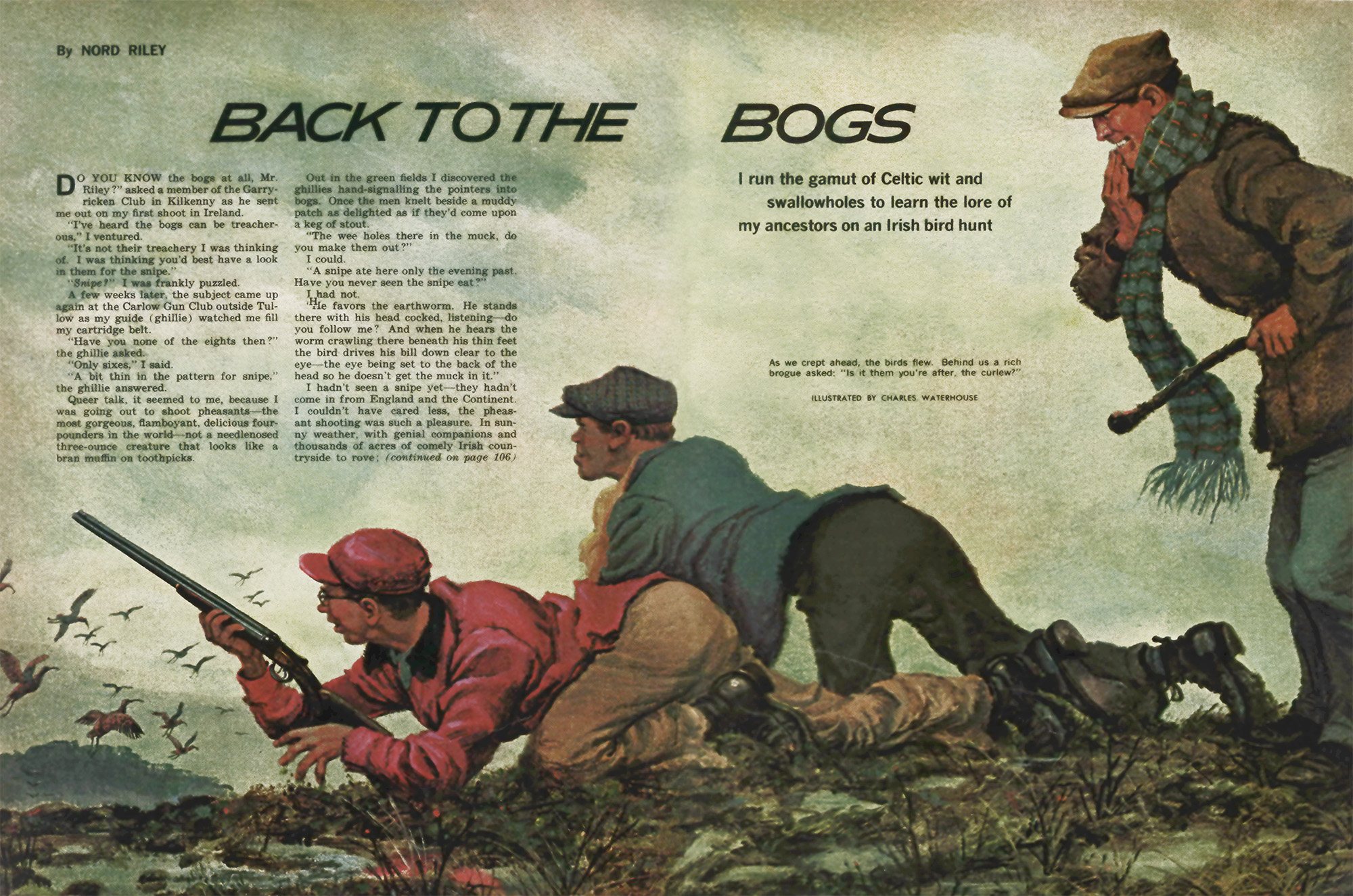
After the briefing on bog-trotting, Christy and I and the lordly Rusty set out to shoot snipe. I loaded my little Spanish double with No. 8’s in 2½-inch shells carrying 1 1/16 ounces of lead. The bog grass was stiff with frost and noisy.
“Oh, God help us,” said Christy, his gloom deepening. “It’s like walking on corn flakes. The birds will be hearing us a half-mile. You’ve got to have wind for snipe-shooting, and you hunt into it. There’s no wind today. No wind at all.”
The first snipe rose 50 yards ahead of us. I didn’t even put my gun up. The second came out of the grass to my left. I missed him badly.
“Too far,” said Christy. “Unless the snipe rises within twenty yards, he’s gone by the time you get your first barrel off.”
When the third snipe got up and I missed him by at least eight feet, I began to see snipe-shooting in a new light. The first thing I noticed was that the Irish version of snipe doesn’t fly like our jacksnipe. This Celtic demon makes our bird look like a little old lady from Pasadena. No rolling, sedate curves for him; this bird makes sharp turns. He corners. Not only can an Irish snipe make right-angle turns — he also makes acute angles. He doesn’t do this with malice aforethought. It’s his normal way of getting to an altitude he fancies.
Almost invariably, this snipe dashes to the right, cuts back to the left, and then back to the right, zigzagging until he is as high as he wants to go. Once at the proper altitude, the snipe simply flies like a drunken bird — a lot of careening, a lot of flying on his side, and once in a while, I’ve heard, he flies on his back.
In October and November, snipe come tearing in from England and the Continent in vast numbers to get out of the cold. You’d think you might drop one by firing into a flock, but you won’t. Snipe don’t associate with each other. In fact, one snipe won’t tell another snipe that somebody’s coming. The snipe eats mainly worms, at night on wet ground. The ghillies had told me that a snipe can hear a worm moving about in the earth and pluck him out; scientists have discovered, however, that, a snipe has extremely sensitive nerve-endings in his bill and that he locates worms by random probing. At daybreak the snipe normally flies back to drier grass where he lounges about all day by himself. What snipe do when the ground freezes hard is a mystery. My opinion is that when the bird rears back and tries to sink his bill into the frozen muck, he gets such a headache that he wobbles off for an aspirin. At any rate, snipe leave frosted bogs. In the bog that we were hunting, Christy normally puts up 40 or 50 snipe; this time we’d put up three, all at a distance.
When the fourth snipe rose, I was so shaken by his aerial tour de force that I couldn’t make up my mind when to fire. So I followed his crazy flight with my double, looking, I imagine, like a gent with a nervous disorder. When I finally pulled, the snipe fell.
“Good shot’” cried Christy. “At least forty-five yards.”
Rusty fetched the bird. and I looked at it. The Irish snipe is much larger than our jacksnipe.
“Ducks,” said Christy without enthusiasm. A dozen teal had gotten up. They circled and then settled.
“Would you mind shooting a duck?” He looked ashamed of himself for asking. “The snipe aren’t here today, and without a wind there won’t be any shooting them.”
Mind a duck, Christy? After trying to hit snipe? Ducks fly straight. None of this butterfly stuff.
We thought we had a chance to sneak up on the teal, but there were many that we hadn’t seen and the alarm went out. The teal tore down the bog a quarter of a mile and lit. Christy and Rusty set off to drive the birds back to where I crouched behind a grass-covered pile of forgotten peat.
The first batch of 50 or 60 teal passed on my right at extreme range, and I wasted a barrel on them. When I turned back I found another flock almost upon me. With my old Winchester Model 12 pump gun I could have slid in a third shell and been ready for three hilarious misses. but I had a double with two triggers that are complete strangers to me. I must put my glasses on to see where the safety is set. I handle the reloading like a cub bear with boxing gloves. The root of my problem is that I am right-handed but must shoot from my left shoulder because of an injury to my right eye. I have to switch the gun back to my right side to reload a double. With the teal coming at me like a flight of rockets, I didn’t even try to put a second shell in. I needed the time to figure out which trigger to pull. When I did, I knocked down a drake greenwing.
On the way back to the car a large brown animal bounded out of the grass and zigzagged off like a terrestrial snipe. An Irish hare. Him I could hit. He weighed ten or twelve pounds, Christy said. Hares are common in Ireland, and they differ from rabbits in that hares don’t live in burrows and their flesh is dark.
Now that we had decided to forget snipe and go for ducks, Christy and I went to bogs that contained open water. On the way to one bog we saw a crowd of birds crossing the road in front of us. Disorderly as crows, they flew with a jerky, pumping action. They had oddly short necks, like alarmed turtles.
“Plover,” said Christy. And when I said that was ridiculous, I’d seen plover yesterday and they hadn’t been anything like these louts, he added: “Lapwing plover. They fly like fools but they’re dead crafty.”
The plover were flying over trees that lined the road on one side. I stopped the car, stepped outside, and got close enough to shoot two. Lapwings not only fly funny but they also look like clowns. Big as pigeons, they have longish legs and short bills, are white underneath and iridescent above, and have a plume sticking out the back of their heads like a cowlick. Lapwings don’t impress me. I still think Disney thought them up.
In this section of County Galway, with the Connemara mountains between us and the sea, bogs are everywhere in the undulating landscape. This is grazing country, and the myriad pastures are separated by loose stone fences. From my prairie youth I’m pretty deft with barbed-wire fences, but stone fences defy me. When I put a leg over I get hung up and am sometimes left behind, howling. When I try to scale the stones as the Irish do, I knock the fence down, generally onto my instep.
Except for the fences, I could have been back in North Dakota pothole hunting. We went from bog to bog, putting up about 100 teal in one, 10 in another, 40 in another. In each one Christy would scare the birds toward me and I’d get in my two licks. Sometimes I got one, a few times two, and once — when I did reload — I got three.
Late in the afternoon after we’d run into some mallards and had taken three of them, we tried a long bog that narrowed in the center. Christy motioned.
“There! There on the grass, do you see them? “
After a bit of squinting I made out a couple of dozen large brownish birds with long downward-curving bills that were at least four inches long.
“Curlew,” said Christy, his voice full of excitement. “They’re the cunning ones, warier than geese, wariest of all.”
We set out to sneak up on the curlew. First, we bent double and pussyfooted, and then we went to our hands and knees. Seventy-five yards out we sank to our bellies for the final slither. We were advancing like lizards when the curlew simply flew across the bog.
“Is it them you’re after, the curlew?”
The voice was immediately above me and rich in brogue. I rolled over on my back and gazed up six feet of rough clothing into the face of — I thought — John Huston, the eminent film director who has become an Irish citizen and lives near Tuam.
“Ah, it’s you, Paddy,” said Christy, rising with a groan. “Now wasn’t it grand of you to come striding down the hill like that, the whole height of you shining in the sun to watch us creep up on the curlew.”
“Not a’tall. I came down to tell you that you weren’t keepin’ low enough,” said Paddy, the glint of laughter deep in his eye. “A difficult bird, the curlew. Not one to wait for the shot.”
I still thought it was John Huston, but it was really Paddy Ryan down from his cottage for a conversation.
Paddy adjusted his cloth cap to the sun and squinted down the bog.
“Now what you’d better be doin’ is creep in’ up on the teal (pronounced tale) in the bog there” — he indicated the lower end — “stayin’ only on the right and then givin’ them the two barrels on the rise.”
“What about going in on the left, too?” I asked. Paddy regarded me thoughtfully. “Ah, you could, you could, could he not, Christy?” He paused. “If you don’t mind disappearin’.”
Christy agreed that it was a devil of a bog.
One of the joys of bog hunting is the affable Irish farmer. I’ve met several now, and no more amusing man lives, nor one freer with advice on how to hunt. We’d lost our chance at the curlew, but I’d rather have met Paddy Ryan.
“For the evening shoot,” said Christy when we got back to the car, “do you want to have another go at the curlew or at wood pigeon?”
I chose the curlew; I’d never shot one. Pigeons I had, only an hour ago. As I had left a bog to inspect the ruins of an Irish castle and eat an apple (there are always castle ruins to enjoy when you hunt in Ireland), a pair of the big gray birds went high over me. I dropped one with the second barrel. Besides, pigeons are a pest in this country and can be shot anytime: curlew I might never have another crack at.
We returned to the first bog we’d hunted. The sun had set.
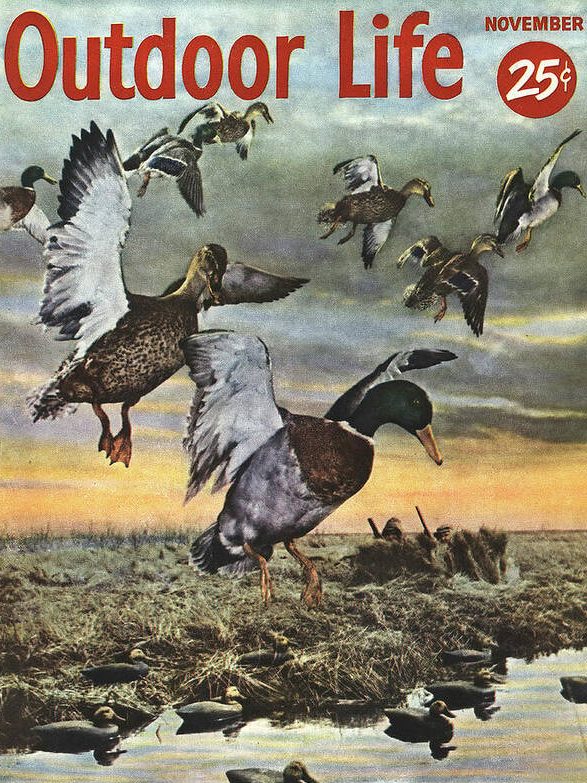
“Curlew come in here at night,” Christy said. They were already in, and their cries, eerie as a loon’s, Cur-lee, Cur-lee, came down the bog in the darkness. Christy set me behind a hump of peat and left to drive the curlew to me.
A crescent moon rose. Stars came out, and the lights of farms went on. A cyclist wove down a road with his headlamp on; I heard children laughing far away. I should have felt enthralled. Instead I felt like a criminal. Wherever I’d hunted it had been illegal to shoot after sundown, and I couldn’t get accustomed to the fact that Ireland allows night shooting; in fact there are few game laws of any kind. Limits, for example, are seldom imposed except perhaps on pheasants by individual clubs.
Way down the bog Christy fired twice. Half a minute later a flock of birds suddenly appeared on my left. I had a glimpse of long, downward-curving bills, and I sent two loads at them with no effect whatever. When I went into my reloading act a mob of lapwing flew right over me at 30 feet. I moved from the peat pile to see better. I heard the creak of fast wings, and four birds went by me so fast that I couldn’t believe it.
“Hopped-up snipe,” I told myself. But snipe don’t fly so straight, and they fly alone. More came whizzing by, and I couldn’t even get my gun up. For the next batch I had it up, waiting. As the birds sped by the Big Dipper, I led them ridiculously far and shot. One fell.
“Did you have a shot at the golden plover?” Christy and Rusty appeared out of the gloaming.
So that was what I had shot, a bird of dazzling speed and very good in soups.
“Shall we wait for the curlew?” Christy asked. “They fly best about eleven o’clock.”
As entertaining as an Irish bog is at night, I couldn’t see standing around in it up until 11 p.m. For one thing my feet were cold, and for another, Betty would have a search party out probing swallowholes for a middle-aged American who floats badly.
Read Next: The Duck Dog Who Wouldn’t Quit, Even If It Killed Him
Christy didn’t really want to leave. He felt that he’d let down the American hunter who had come a long way for snipe. It had been a bad day, he said.
A bad day was it? We had started out to shoot snipe, and a white frost had driven them from their usual habitat. Yet on a bright, windless day — bane of waterfowlers everywhere — we had been able to turn from snipe to other game. A bad day in Ireland would have been a good season in California. And that was not all. I had met Paddy Ryan. And eaten an apple in a castle ruin. And learned a bit of the lore of my ancestors — bog-trotting.
The post I Moved to Ireland, Where Snipe are the Ultimate Game Bird appeared first on Outdoor Life.
Source: https://www.outdoorlife.com/hunting/hunting-snipe-ireland/

